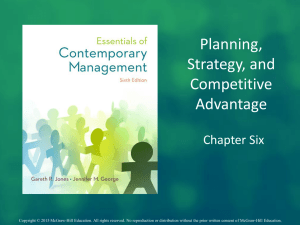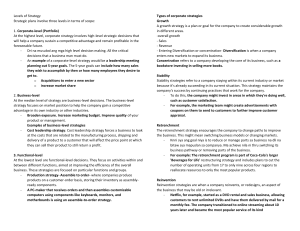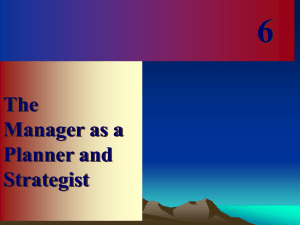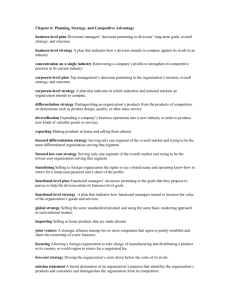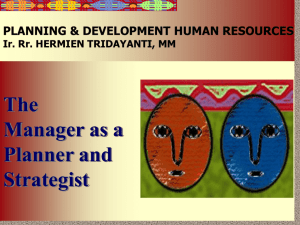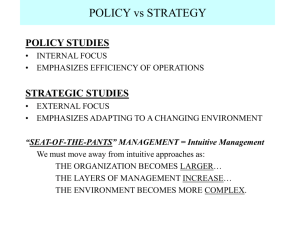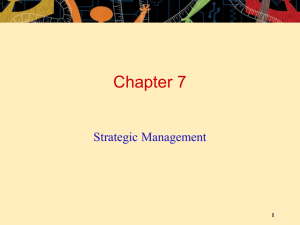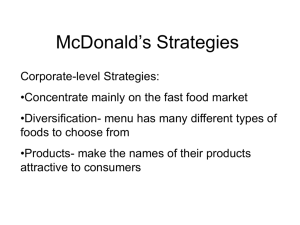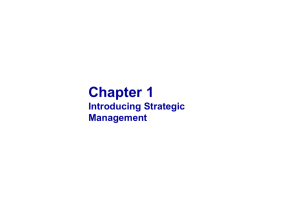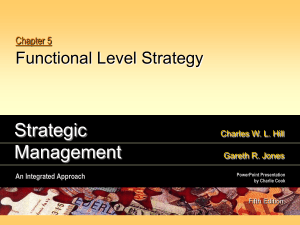STRATEGY FORMULATION and IMPLEMENTATION
advertisement
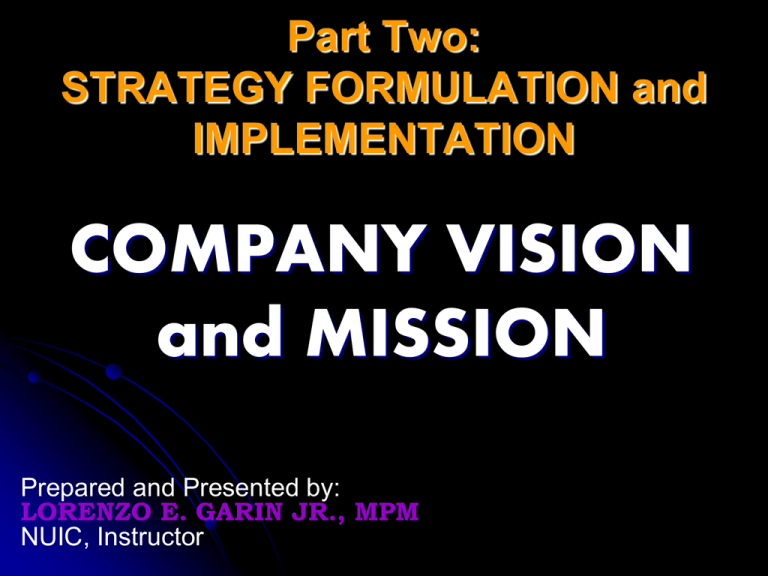
Part Two: STRATEGY FORMULATION and IMPLEMENTATION COMPANY VISION and MISSION Prepared and Presented by: LORENZO E. GARIN JR., MPM NUIC, Instructor Learning Objectives Describe a company mission and explain its value Explain why it is important for the mission statement to include the company basic product or service, its primary markets, and its principal technology Discuss the importance of company philosophy, public image, and company self concept to stockholders Describe the company’s board of directors What is Strategic Management? Strategic Management The set of decisions and actions used to formulate and implement strategies that will provide a competitively superior fit between the organization and its environment so as to achieve organizational goals. What is Company Vision? Defines the desired or intended future state of an organization or enterprise in terms of its strategic direction. Vision is a long term view, sometimes describing how the organization would like the world in which it operates to be. For example a charity working with the poor might have a vision statement which read "A world without poverty Reasons for having a vision statement Gets team focused. Shows a picture of where the company is going. Instills focus, discipline, and structure within the organization. Ensures that team understands company direction. How to write a Vision? Determine the organization's overriding goal State what the organization envisions itself to be in terms of values, employees, growth and contributions to society. Look at vision statements of competitors in the industry Use wording that will inspire your team. Think of adjectives and sentences that will get the team excited and will make them think they are part of something that is much bigger than something they could have thought of themselves. Get other people on the team to critique the draft of the vision to make sure it's effective and inspiring. If there are any key customers the organization trusts, ask them to review the draft too. What is Company Mission? Company Mission The unique purpose that sets a company apart from others of its type and identifies the scope of its operation. In product, market, and technology Mission Definition: A sentence describing a company's function, markets and competitive advantages; a short written statement of your business goals and philosophies A mission statement defines what an organization is, why it exists, its reason for being. At a minimum, your mission statement should define who your primary customers are, identify the products and services you produce, and describe the geographical location in which you operate Importance of Mission Benefits from a strong mission Unanimity of Purpose Resource Allocation Mission Organizational Climate Focal point for work structure Customers Products Services Markets Technology Employees Mission Elements Survival Growth Profit Public Image Self-Concept How to write a Mission? Ask "What do we do?"; "How do we do it?"; and "For whom do we do it," Create a draft mission statement describing how the company uniquely answers these questions. Touch on the organization's current operations and the industry it is in. Look at competitors in the industry and use their mission statements for research. Ask yourself what works and what does not work. Revise your mission statement as needed. Get feedback from other members of the organization once the statement is drafted. The Difference between Vision & Mission Vision - The Future Definition: The way in which one sees or conceives something; a mental image; An overall statement of the goal of the organization. Vision should describe what will be achieved in the wider sphere if the organization and others are successful in achieving their individual missions. The Difference between Vision & Mission Mission - The Present Definition: An assignment one is sent to carry out; a self-imposed duty. A mission statement identifies the reason for the existence of the organization. The statement should be linked to the overall operations and business of the organization A Mission statement is more specific to what the enterprise can achieve itself. Which comes first? That depends. If you have a new start up business, new program or plan to reengineer your current services, then the vision will guide the mission statement and the rest of the strategic plan. If you have an established business where the mission is established, then many times, the mission guides the vision statement and the rest of the strategic plan. Either way, you need to know your fundamental purpose - the mission, your current situation in terms of internal resources and capabilities (strengths and/or weaknesses) and external conditions (opportunities and/or threats), and where you want to go - the vision for the future. It's important that you keep the end or desired result in sight from the start To remain competitive, companies develop strategies that focus on: 1. Core competence 2. Synergy 3. A business activity that an organization does particularly well in comparison to competitors. The condition that exists when the organization’s parts interact to produce a joint effect that is greater than the sum of the parts acting alone. Value Creation The heart of strategy. Value can be defined as the combination of benefits received and costs paid by the customers. Levels of Strategy Corporate-Level Strategy Business-Level Strategy The level of strategy concerned with the question, “What business are we in?”. Pertains to the organization as a whole and the combination of business units and product lines that make it up. The level of strategy concerned with the question, “How do we compete?”. Pertains to each business unit or product line within the organization. Functional-Level Strategy The level of strategy concerned with the question, “How do we support the business-level strategy?”. Pertains to all of the organization’s major departments. Three Levels of Strategy in Organization Corporate-Level Strategy: What business are we in? Corporation Business-Level Strategy: How do we compete? Textile Units Chemicals Unit Auto Parts Unit Functional-Level Strategy: How do we support the business-level strategy? Finance R&D Manufacturing Marketing Corporate-Level Strategy: What business are we in? Corporation Business-Level Strategy: How do we compete? Textile Units Functional-Level Strategy: How do we support the business-level strategy? Finance R&D Manufacturing Marketing Strategy Formulation Versus Implementation Strategy Formulation The stage of strategic management that involves the planning and decision making that lead to the establishment of the organization’s goals and of a specific strategic plan. Strategy Implementation The stage of strategic management that involves the use of managerial and organizational tools to direct resources toward achieving strategic outcomes. Situation Analysis Analysis of the strengths, weaknesses, opportunities, and threats (SWOT) that affect organizational performance. Strengths Weaknesses Internal characteristics that organization’s performance. might inhibit or restrict the Opportunities Positive internal characteristics that the organization can exploit to achieve its strategic performance goals. Characteristics of the external environment that have the potential to help the organization achieve or exceed its strategic goals. Threats Characteristics of the external environment that may prevent the organization from achieving its strategic goals. Competitive Strategies 1. Differentiation 2. Cost Leadership 3. a type of competitive strategy with which the organization seeks to distinguish its products or services from competitors. A type of competitive strategy with which the organization aggressively seeks efficient facilities, cuts costs, and employs tight cost controls to be more efficient than competitors. Focus A type of competitive strategy that emphasizes concentration on a specific regional market or buyer group. Formulating Functional-Level Strategy the action plans adopted by major departments to support the execution of business-level strategy. major organizational functions include marketing, production, finance, human resources, and research & development. Strategy Implementation and Control Implementation is the final step in the strategic management process and it is how strategy put into action. Some people argue that strategy implementation is the most difficult and important part of strategic management. Tools for Putting Strategy into Action Environment Organization LEADERSHIP • Use persuasion • Motivate employees • Shape culture/values Strategy STRUCTURAL DESIGN HUMAN RESOURCES • Design organization chart • Create teams • Determine centralization • Arrange facilities, task design • Recruit/select employees • Manage transfers/promotions/training • Direct layoffs/recalls INFORMATION AND CONTROL SYSTEMS • Revise pay, reward system • Change budget allocations • Implement information systems • Apply rules and procedures Performance Board of Directors The group of stockholder representatives and strategic managers responsible for overseeing the creation and accomplishment of the company mission. Organizational Structure of Corporations Stockholders elect Directors elect Officers (Top Management) President Vice President Treasurer Secretary Board of Directors- job responsibilities To establish and update the company mission To elect the company’s top officers (CEO) To establish the compensation levels of the top officers, including the salaries and bonuses To set broad company policy on such matters as labor-management relations, product or service lines of business, and employee benefit packages To set company’s objectives and to authorize managers to implement the long term strategies that the top officers and the board have found agreeable To mandate company compliance with legal and ethical dictates To determine the amount and timing of the dividends paid to stockholders THE END Any clarification? HAVE A NICE DAY!!!
